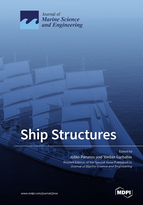Ship Structures
A special issue of Journal of Marine Science and Engineering (ISSN 2077-1312). This special issue belongs to the section "Ocean Engineering".
Deadline for manuscript submissions: closed (20 January 2022) | Viewed by 45327
Special Issue Editors
Interests: ship structures; wave loads; strength and vibration analysis; fatigue analysis; structural reliability analysis
Special Issues, Collections and Topics in MDPI journals
Interests: marine structural design & analysis; fatigue and fracture mechanics; structural degradation; ultimate limit dtate analysis; structural reliability; risk-based maintenance; offshore wind farm
Special Issues, Collections and Topics in MDPI journals
Special Issue Information
Dear Colleagues,
This Special Issue covers research topics related to ship structural design and analysis, aiming to have safe, economical, and comfortable ship structures through their entire lifetime. Analytical, numerical, and experimental researches, as well as review papers and case studies of innovative engineering applications for all types of ship structures are warmly invited. A rapid reviewing process and open-access publication will be provided for high-quality papers on the following topics:
- Probabilistic modeling of waves and wave-induced loads;
- Modelling of ice and ice-induced loads;
- Quasistatic and dynamic structural response prediction;
- Structural design and optimization;
- Ultimate strength of plates, stiffened panels, and hull girders;
- Fatigue strength and crack growth of welded structures;
- Uncertainty modeling, reliability, and risk-based methods;
- Springing and whipping of ship structures;
- Collision and grounding;
- Vibration and noise;
- Corrosion degradation and resulting structural strength;
- Maintenance planning of ship structures;
- Full-scale measurements and structural health monitoring;
- Composites and hybrid ship structures.
Prof. Joško Parunov
Prof. Yordan Garbatov
Guest Editors
Manuscript Submission Information
Manuscripts should be submitted online at www.mdpi.com by registering and logging in to this website. Once you are registered, click here to go to the submission form. Manuscripts can be submitted until the deadline. All submissions that pass pre-check are peer-reviewed. Accepted papers will be published continuously in the journal (as soon as accepted) and will be listed together on the special issue website. Research articles, review articles as well as short communications are invited. For planned papers, a title and short abstract (about 100 words) can be sent to the Editorial Office for announcement on this website.
Submitted manuscripts should not have been published previously, nor be under consideration for publication elsewhere (except conference proceedings papers). All manuscripts are thoroughly refereed through a single-blind peer-review process. A guide for authors and other relevant information for submission of manuscripts is available on the Instructions for Authors page. Journal of Marine Science and Engineering is an international peer-reviewed open access monthly journal published by MDPI.
Please visit the Instructions for Authors page before submitting a manuscript. The Article Processing Charge (APC) for publication in this open access journal is 2600 CHF (Swiss Francs). Submitted papers should be well formatted and use good English. Authors may use MDPI's English editing service prior to publication or during author revisions.
Keywords
- Ship structures
- Loads
- Structural optimization
- Ultimate strength
- Fatigue and fracture
- Structural reliability
- Hydroelasticity
- Crashworthiness
- Vibration and noise
- Corrosion degradation







